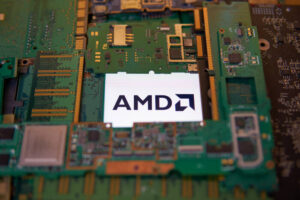Tariffs and Inventory Challenges Weigh on AMD’s Growth Outlook
In a rapidly evolving tech landscape, Advanced Micro Devices (AMD) has been a beacon of top-line growth. However, recent shifts stemming from external factors—particularly China-related export controls—are causing analysts to reassess their predictions for the company. As we delve deeper into AMD’s current situation, we at the Extreme Investor Network aim to equip investors with insights that not only inform but also inspire strategic decisions.
Impact of Tariffs and Export Controls
The landscape is shifting, as highlighted by UBS analyst Timothy Arcuri’s notable reduction of AMD’s full-year earnings per share (EPS) target from $4.46 to $3.61. The culprit? A complex combination of tariffs and diminished global demand—challenges that many companies are grappling with in our interconnected world. AMD recently revealed an eye-popping potential $800 million charge related to export licensing for the MI308 chips. This revelation underscores the unforeseen hurdles that can emerge in the tech industry.
The division among analysts is palpable. While firms like Bank of America, Deutsche Bank, and Wedbush have slashed their price targets—some by up to $45—Citi takes a contrarian stance by maintaining a bullish outlook. They point to the unstoppable wave of artificial intelligence (AI) capital expenditures, predicting that tech giants like Meta, Microsoft, and Alphabet will collectively invest a staggering $200 billion in AI infrastructure by 2025. This cleft in predictions serves as a reminder for investors to evaluate the fundamentals beyond mere numbers.
Business Segments: A Mixed Bag
Even as AMD faces headwinds, a closer look reveals a mixed performance across its business segments. The company is witnessing strength in its data center and client segments, but these gains are overshadowed by declines in gaming and embedded units.
Gaming revenue is projected to plummet 38.1% year-over-year, estimating around $570 million as semi-custom chip sales falter. The embedded sector isn’t faring much better, with revenues anticipated to dip 0.9% to $838 million, reflecting tepid industrial and communications demand.
On a brighter note, the client revenue segment is anticipated to soar nearly 50% to $2.04 billion, largely fueled by rising demand for Ryzen processors in commercial PCs. This varied performance offers both challenges and opportunities, stressing the importance of a nuanced investment approach.
The Bullish Sentiment Amidst Caution
As we evaluate the broader market, an underlying theme emerges: cautious optimism. The AI boom is proving to be a crucial tailwind, offering a path forward for companies like AMD that are strategically positioned to capitalize on these developments. While immediate challenges loom, the promise of AI investment heralds a transformative period for the tech industry.
Takeaway: At Extreme Investor Network, we recognize that navigating the stock market requires a keen understanding of both macroeconomic trends and company-specific dynamics. As we monitor AMD’s performance and the broader tech landscape, we encourage our readers to stay informed, adapt strategies, and seize opportunities that arise amidst uncertainty.
In this ever-evolving market, the key to success lies in staying proactive and informed. By focusing on long-term growth dynamics and embracing innovation, investors can position themselves for a prosperous future in the tech sector.

